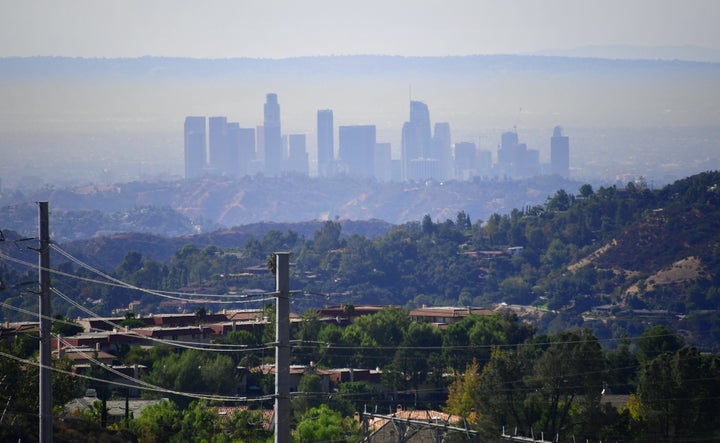
Opinion | People Of Color Aren’t Safe Under Scott Pruitt’s EPA
The Environmental Protection Agency under the Trump administration has shown no interest in protecting the health of all people ― and the agency actually seems averse to protecting the health of people of color.
Consider smog, a type of air pollution formed when exhaust from vehicles and power plants heats up in the sun. It is a major contributor to asthma and premature death. One 2014 study found that people of color live in communities with 38 percent more nitrogen dioxide, a compound that is a precursor for the formation of smog.
The nation has made strides in reducing this type of pollution and was on track to do an even better job when the EPA, under former President Barack Obama, set more protective smog standards in 2015.
Last October, the EPA was required to pinpoint those areas of the country that weren’t meeting the 2015 air quality standard, so action could be taken to clean up the air.
But instead of identifying all those problem areas, EPA Administrator Scott Pruitt simply ignored federal law by missing the October deadline. In fact, Pruitt has stalled numerous environmental regulations by delaying action or deciding to revisit rules that were set for implementation.
This prompted Earthjustice, the nonprofit I work for, to sue him on behalf of a number of health and environmental groups, including the American Lung Association, National Parks Conservation Association and Environmental Defense Fund.
Pruitt’s inaction is one of many examples of how the Trump administration has attempted to stall the implementation of required health protections so that corporations can focus on their bottom lines, rather than on the communities or neighborhoods they may be polluting.
Pruitt’s actions indicate nothing is safe. Earlier this month, he announced his decision to rescind Obama’s Clean Power Plan, which would have reduced carbon emissions, a primary driver of climate change. And he’s planning to scale back regulations that protect streams and other wetlands from pollution, which has affected the wildlife and drinking water that communities depend on.
The quality of your air and water ― and your exposure to toxic and hazardous substances ― is determined to a great extent by your race and income.
Pruitt’s disregard for the health of our communities comes as no surprise, considering he has spent much of his tenure as Oklahoma’s attorney generalfighting environmental protections on behalf of corporate interests.
At the end of October, Pruitt issued a directive barring scientists who have received grants from the EPA from serving on science advisory committees.
Many of those who have served on these committees and have received EPA grants are highly qualified medical professionals and expert university academics who have guided the agency on scientific and technical matters. Instead, Pruitt has begun replacing them with people that have a track record of disagreeing with established scientific research and in some cases have financial connections to polluting industries.
One of these new appointees to the Science Advisory Board, Robert Phalen, the former director of the Air Pollution Health Effects Laboratory at the University of California, Irvine, claims that air pollution is good for children. He has also said that “modern air is a little too clean for optimum health.”
Pruitt has appointed other people who’ve downplayed the effects of pollution to lead the Science Advisory Board. This includes Michael Honeycutt, lead toxicologist at the Texas Commission on Environmental Quality, who has expressed doubt about the overwhelming evidence that smog causes asthma. Honeycutt has served on the Alliance for Risk Assessment, which conducts research for polluters, including the American Chemistry Council and Coca-Cola.
The quality of your air and water ― and your exposure to toxic and hazardous substances ― is determined to a great extent by your race and income.

People of color have limited access to the healthiest environments and are more likely to live near highways, garbage dumps and toxic waste sites. Even people of color who are middle class are forced to breathe worse air than their white counterparts.
The health impacts of these environmental disparities are clear. One in six black children has asthma, a rate that is about double the proportion of white children with the disease. One in five Puerto Ricans across the U.S. has asthma, which is the highest of any racial or ethnic group in the nation. And thousands die from the disease every year.
More than two decades ago, the EPA first began addressing this issue of environmental injustice when then-President Bill Clinton, following pressure from community and environmental justice groups, issued Executive Order 12898. It directed federal agencies to address the disproportionate burden faced by communities of color and low-income populations.
I was the adviser on environmental justice for two EPA administrators ― Lisa Jackson, the first African-American to serve in that role, and Gina McCarthy ― both Obama appointees. My role existed because of pressure from environmental and community groups, and because of the Obama administration’s desire to fully implement Clinton’s executive order. It took years to deepen the EPA’s focus on environmental justice so that disproportionate impacts and health disparities were considered when environmental regulations were drafted or updated.
Throughout the Obama administration, the EPA focused on improving health in communities by creating a new environmental justice-focused strategy with Plan EJ 2014. This, in part, offered screening tools to identify environmental threats and disparities wherever they exist in the U.S. That effort continued the Environmental Justice 2020 Action Agenda, the agency’s commitment to work in the 100 communities most overburdened by pollution.
But last spring, Pruitt proposed eliminating the EPA’s Office of Environmental Justice by gutting the $2 million allocated to run it.
Pruitt and President Donald Trump’s lack of concern for healthy communities, while deeply troubling, has not caused environmental leaders of color to bury their heads in the sand. We’re resolved to fight even harder.
In California, for instance, communities have been at the forefront of demanding zero-emissions technology, knowing that communities of color bear the brunt of air pollution from fossil fuels. And last spring, the Los Angeles County Metropolitan Transportation Authority committed to ending their use of natural gas-powered buses and replacing them with all electric buses by 2030, in large part due to communities’ efforts.
In April, the New York City Council passed the most comprehensive environmental justice legislation found in any U.S. city, requiring the local government to address pollution in overburdened communities. Environmental justice groups across the city, including the New York City EJ Alliance and the Harlem-based We ACT for Environmental Justice, played a leading role in developing this legislation and getting it across the finish line.
These efforts in California and New York, small examples among many in this nation, show how democracy can function when local and state leaders carry out the will of communities determined to protect their health.
Lisa Garcia is the vice president of Litigation for Healthy Communities at Earthjustice, where she directs litigation that helps protect communities and families from a wide range of pollution issues.
This piece is part of HuffPost’s brand-new Opinion section. For more information on how to pitch us an idea, go here.



